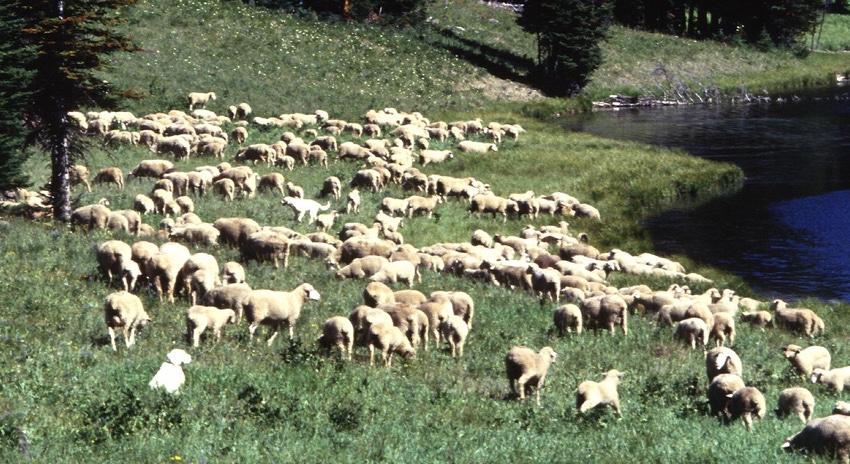March 2, 2022

The financial profit of sheep flocks hinges on production efficiency. Technology utilized in the U.S. cattle industry has the potential to inform flock management decisions, too. A University of California Agriculture and Natural Resources (UCANR) research team partnered with California sheep producers to test electronic identification and genomic technologies.
Genetic testing remains under development for the US sheep industry. UCANR researched how genomic data, analyzed by Flock54, determined parentage and can be evaluated for breeding values. For the test, UCANR worked with five sheep producers in western California to collect ear notch samples from all of their rams and at least 500 market lambs per ranch over a yearlong period.
The UCANR research showed which rams exhibited the most virility. “One of the superstar bucks produced 70 male lambs,” remarks Julie Finzel, Livestock and Range Advisor with University of California Cooperative Extension. “We only genetically tested male lambs. The gender split for lambs is usually about 50/50, so we can assume that superstar buck produced 70 female lambs as well. That’s 140 lambs in one breeding season for that ram. On average, it is thought that one ram can cover 40 ewes. Depending on the twinning rate, it is then expected there will be 70 lambs per buck. The superstar bucks doubled the normal accepted rate.”
Genetic testing can be utilized to track twinning, but for that data the ewes would need to be sampled. The current costs of genetic technology do not justify testing all rams and ewes in a commercial flock. Finzel says testing the entire flocks of seedstock or purebred producers would help identify the top-producing genetics and provide financial return. Besides the costs of testing, another challenge is its timeline.
“We tested the rams and by the time the genetic data was compiled,” recalls Finzel, “two breeding seasons and two lambings had passed. Our intention was for the test results to be a decision-making tool for breeding season, but the technological process isn’t quick enough yet. When we finally sent the genetic information, which highlighted the superstar bucks, to producers, they responded, ‘I sure hope I didn’t cull that ram.’”
The identified breeding values are flock specific. Each producer, per their management, environment, and production goals, crossbreeds commercial flocks uniquely. This limits the application of genetic values developed from a single flock to others. “In the study, we a producer who focuses on their wool and a very specific micron range,” Finzel explains. “Another producer focuses solely on meat.” An initiative, Sheep Genetics USA, seeks to further develop the genomic technology and facilitate its use.
How to track the data
When paired with genetic breeding values, electronic identification ear tags easily tracked data. Electronic identification (EID) can be utilized to track animals individually and specific traits. In the UCANR study, three of the five producers involved had previously tagged sheep with EIDs. All of the rams and wether lambs genetically tested were tagged with EIDs for tracking purposes.
“The advantage of the electronic IDs is apparent when you have genetic information,” Finzel says, “because you can quickly tell out in the corral which animals are lower performing.” Producers, that use EIDs, find that they help sort out the bottom 10-to-15% of the flock that isn’t productive and lessens financial profits.
Inserting and scanning EIDs does lengthen the time necessary to work sheep. Finzel notes that producers with a few hundred sheep are more apt to utilize EIDs. Few producers with several bands of sheep have adopted EIDs due to the costs and labor involved. Even without genetic data, EIDs handily track parentage of the highest performing lambs to inform breeding decisions for flock efficiency and production.
Finzel recommends producers select, at most, three traits to track when they begin with EIDs. “One producer laid out 20 traits that he wanted to track,” she says. “About five lambs in they realized it was taking five minutes per lamb, and that wouldn’t work. It is better to start with some key improvement areas and focus on improving those in your flock. For instance, track lamb weights and connect parentage to breed for heavier lambs. Then, once there’s positive changes there, move onto other criteria.”
Often seedstock producers track parentage, yet it is also helpful for commercial producers to know which ewes consistently produce twins and the bigger lambs. Finzel has worked with producers that utilized EIDs for their purbred targhee flock. They decided to begin tagging their commercial targhee flock with EIDs, too. They soon found that their largest ewes produced the smallest lambs when weighed at weaning.
“The producers thought that their largest ewes produced the largest lambs,” Finzel says, “but tracking with the EID tags showed that they assumed incorrectly. The producers culled those ewes and focused on the ewes that produced the heaviest lambs.” Every breeding season producers seek to improve their flocks. The UCANR study paired two technologies — genetic testing and EIDs — that can provide data, and then track it, for informed flock management decisions.
About the Author(s)
You May Also Like




